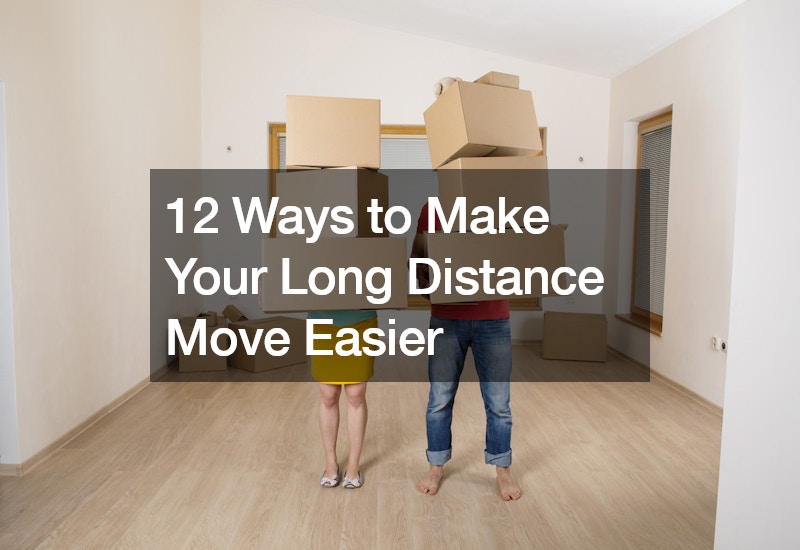Moving long distances can be a daunting task, but with proper planning, the right resources, and the help of local movers, it can be a smooth and stress-free experience. Here are twelve ways to make your long-distance move easier, ensuring that you stay organized and focused throughout the process.
1. Plan Ahead and Stay Organized

One of the most critical steps in a successful long-distance move is thorough planning and staying organized.
Create a Moving Checklist
A moving checklist is essential to keep track of tasks and ensure nothing is overlooked. Start by listing everything that needs to be done, from hiring a moving company to changing your address. Break down tasks by week and set deadlines to stay on track.
Budget for Your Move
Long-distance moves can be expensive, so it’s crucial to budget accordingly. Consider all potential costs, including the moving company, packing supplies, travel expenses, and temporary accommodations. Having a clear budget helps you manage your finances and avoid unexpected expenses.
Hire a Licensed Mover
Hiring a licensed mover is crucial for a successful long-distance move. Licensed residential movers are regulated and insured, providing peace of mind that your belongings will be handled professionally. Research long distance moving companies, read reviews, and ask for recommendations to find a reliable and licensed mover.
2. Declutter and Downsize
Moving is an excellent opportunity to declutter and downsize your belongings, making the process more manageable and cost-effective.
Sort Through Your Belongings
Go through each room and decide what to keep, donate, sell, or throw away. Reducing the number of items you need to move can save time and money. Be honest with yourself about what you really need and use.
Host a Garage Sale
Selling unwanted items can help offset moving costs. Host a garage sale or sell items online through platforms like eBay, Facebook Marketplace, or Craigslist. Not only will this reduce the volume of your move, but it will also provide extra cash for the journey.
Donate Unused Items
Consider donating gently used items to local charities or shelters. This can be a fulfilling way to downsize and help others in need. Make sure to get a receipt for your donations, as they may be tax-deductible.
3. Pack Smart

Packing is one of the most time-consuming aspects of moving. Using smart packing strategies can make the process more efficient and protect your belongings.
Invest in Quality Packing Supplies
Investing in quality packing supplies is essential to protect your belongings during the move. Use sturdy boxes, packing tape, bubble wrap, and packing paper. Consider purchasing specialty boxes for fragile items like dishes and electronics.
Label Boxes Clearly
Clearly label each box with its contents and the room it belongs to in your new home. This makes unpacking easier and ensures that boxes end up in the correct location. Color-coding boxes by room can also streamline the process.
Pack an Essentials Box
Pack a box with essential items you’ll need immediately upon arrival, such as toiletries, a change of clothes, important documents, and basic kitchen supplies. This will make the first few days in your new home more comfortable.
4. Utilize Professional Services
Professional services can significantly ease the burden of moving, offering expertise and convenience.
Hire Full Service Packing and Moving
Full service packing and moving companies handle every aspect of your move, from packing your belongings to transporting them and unpacking at your new home. This option is ideal for those who want a stress-free moving experience. Although it may be more expensive, the convenience and peace of mind can be worth the cost.
Consult Real Estate Agents
Real estate agents can provide valuable assistance during a long-distance move. They can help you find a new home, navigate the buying or renting process, and offer insights into your new community. Their expertise can make the transition smoother and more efficient.
Consider Custom Storage Solutions
If your new home isn’t ready immediately or you need to store items temporarily, custom storage solutions can be very helpful. Many moving companies offer storage services, or you can rent a storage unit. Custom storage options can accommodate items of all sizes and provide secure, climate-controlled environments.
5. Prepare Your Vehicle

Preparing your vehicle for a long-distance move is crucial, whether you’re driving to your new location or having your vehicle transported.
Service Your Vehicle
Before a long drive, ensure your vehicle is in good condition. Schedule a maintenance check to address any potential issues, such as oil changes, tire rotations, and brake inspections. This helps prevent breakdowns and ensures a smooth trip. In the event that you have an electric vehicle, look into proper electric vehicle battery storage to ensure that it is transported safely.
Consider Trailers for Sale
If you have a lot of belongings to move, consider looking at trailers for sale. A trailer can provide additional storage space and make transporting your items easier. This is particularly useful for those with large items or a significant volume of belongings.
Invest in a Truck Bed Cover
A truck bed cover can protect your belongings from weather and theft during the move. It provides a secure, enclosed space in your truck bed, ensuring your items stay safe and dry throughout the journey.
6. Stay Safe and Healthy
Moving can be physically and mentally taxing. Prioritizing your health and safety is essential for a successful move.
Stay Hydrated and Eat Well
Moving can be exhausting, so it’s important to stay hydrated and eat nutritious meals. Keep water and healthy snacks readily available. Avoid skipping meals and try to maintain a balanced diet to keep your energy levels up.
Take Breaks and Rest
Don’t overexert yourself during the moving process. Take regular breaks to rest and recharge. Moving is a marathon, not a sprint, and pacing yourself can prevent injuries and burnout.
Use Proper Lifting Techniques
Lifting heavy boxes and furniture improperly can lead to injuries. Use proper lifting techniques, such as bending at the knees and keeping your back straight. If an item is too heavy, don’t hesitate to ask for help or use moving equipment like dollies and straps.
7. Manage Stress and Stay Positive
Moving, especially long distances, can be stressful. Managing stress and maintaining a positive attitude can make the process more enjoyable.
Practice Stress-Relief Techniques
Incorporate stress-relief techniques into your routine, such as deep breathing exercises, meditation, or yoga. Taking time to relax and unwind can help you stay calm and focused.
Stay Connected with Loved Ones
Stay in touch with friends and family during the move. Their support can be invaluable, and talking to loved ones can help alleviate stress. Use video calls, phone calls, and social media to stay connected.
Focus on the Positive Aspects
Remind yourself of the positive aspects of the move, such as new opportunities, a fresh start, and exciting experiences. Keeping a positive outlook can help you stay motivated and look forward to your new adventure.
8. Protect Your Belongings
Ensuring the safety of your belongings during a long-distance move is paramount. Taking extra precautions can prevent damage and loss.
Get Moving Insurance
Consider purchasing moving insurance to protect your belongings during the move. While most long distance moving companies offer basic coverage, it may not be sufficient for valuable items. Moving insurance provides additional peace of mind and financial protection in case of damage or loss.
Secure Valuables and Important Documents
Pack valuables and important documents separately and keep them with you during the move. This includes items like jewelry, passports, birth certificates, and financial records. Keeping these items in your possession reduces the risk of loss or theft.
Use Quality Packing Techniques
Ensure that fragile items are packed securely with plenty of cushioning. Use bubble wrap, packing paper, and sturdy boxes to protect your belongings. Avoid overloading boxes, as this can increase the risk of damage.
9. Coordinate and Communicate
Effective coordination and communication are key to a successful long-distance move. Keeping everyone informed ensures a smooth process.
Coordinate with Your Moving Company
Stay in close communication with your moving company throughout the process. Confirm details such as pick-up and delivery times, special instructions, and contact information. Clear communication helps prevent misunderstandings and ensures that everything goes according to plan.
Inform Your Contacts
Notify important contacts of your move, including utility companies, banks, and healthcare providers. Update your address with the post office and any subscriptions or services you receive. Ensuring that everyone is informed of your move can prevent disruptions and ensure that you continue to receive essential services.
Communicate with Your Family
Keep your family members informed about the moving timeline and their roles in the process. Clear communication can help everyone stay on the same page and work together efficiently. Assign tasks to each family member to share the workload and ensure a smooth move.
10. Settle into Your New Home

Once you’ve arrived at your new home, taking steps to settle in quickly can help you feel more comfortable and reduce stress.
Unpack Essentials First
Start by unpacking the essentials box you packed earlier. This includes items you’ll need immediately, such as toiletries, kitchen supplies, and basic tools. Getting these items set up first can make your new home feel more functional and comfortable.
Explore Your New Neighborhood
Take time to explore your new neighborhood and get familiar with your surroundings. Locate essential services such as grocery stores, pharmacies, and healthcare facilities. Exploring your new area can help you feel more at home and connected to your new community.
Set Up Utilities and Services
Ensure that all utilities and services are set up and functioning in your new home. This includes electricity, water, internet, and trash collection. Contact your service providers in advance to schedule installations and avoid any disruptions.
11. Seek Professional Help
Sometimes, seeking professional help can make a significant difference in the moving process. Don’t hesitate to enlist experts when needed.
Work with Real Estate Agents
Real estate agents can provide valuable assistance during a long-distance move. They can help you find a new home, navigate the buying or renting process, and offer insights into your new community. Their expertise can make the transition smoother and more efficient.
Consider Full Service Packing and Moving
Full service packing and moving companies handle every aspect of your move, from packing your belongings to transporting them and unpacking at your new home. This option is ideal for those who want a stress-free moving experience. Although it may be more expensive, the convenience and peace of mind can be worth the cost.
Utilize Custom Storage Solutions
If your new home isn’t ready immediately or you need to store items temporarily, custom storage solutions can be very helpful. Many moving companies offer storage services, or you can rent a storage unit. Custom storage options can accommodate items of all sizes and provide secure, climate-controlled environments.
12. Plan for the Unexpected
Despite thorough planning, unexpected situations can arise during a move. Being prepared for these scenarios can help you navigate them smoothly.
Have an Emergency Fund
Set aside an emergency fund to cover unexpected expenses during the move. This could include vehicle repairs, medical emergencies, or last-minute accommodations. Having extra funds available can alleviate stress and provide a safety net in case of unforeseen events.
Stay Flexible
Flexibility is key during a long-distance move. Be prepared to adjust your plans if necessary and stay open to alternative solutions. Staying flexible can help you manage unexpected challenges more effectively and reduce stress.
Maintain a Positive Attitude
A positive attitude can make a significant difference during a move. Focus on the opportunities and new experiences that come with moving to a new place. Maintaining a positive outlook can help you stay motivated and navigate challenges with a clear mind.
A long-distance move can be a complex and challenging process, but with careful planning and the right strategies, it can also be a rewarding experience. By following these twelve tips, you can make your long-distance move easier and more efficient. From hiring a licensed mover and utilizing full service packing and moving companies to staying organized and maintaining a positive attitude, each step contributes to a successful transition to your new home. Embrace the adventure and look forward to the new opportunities that await you.


